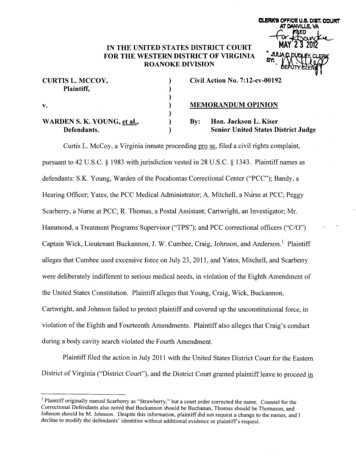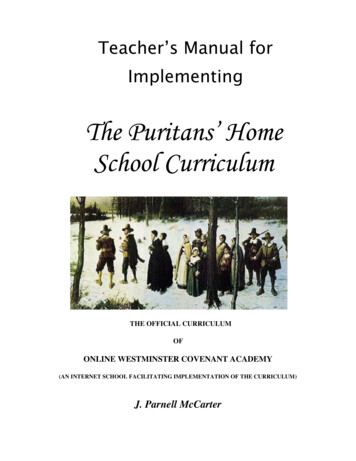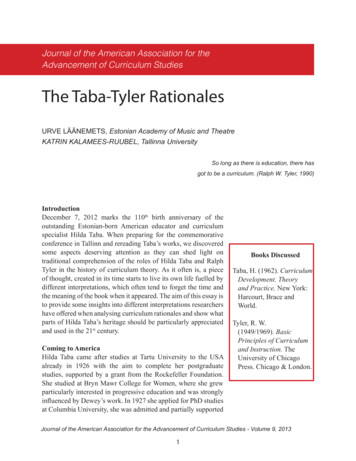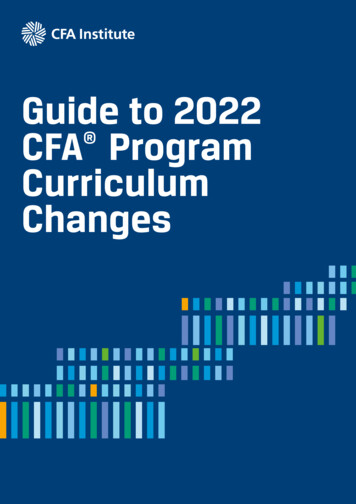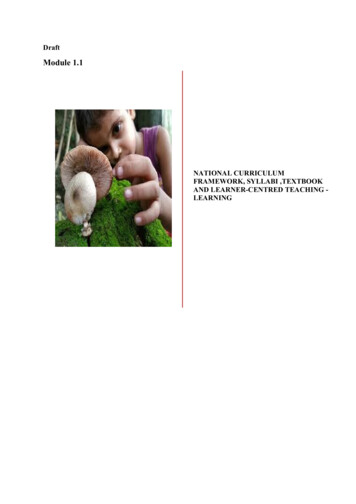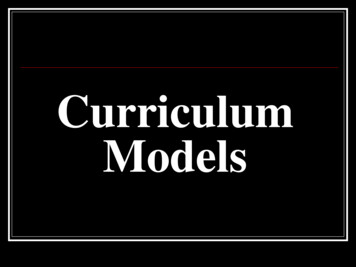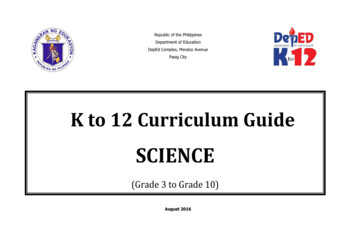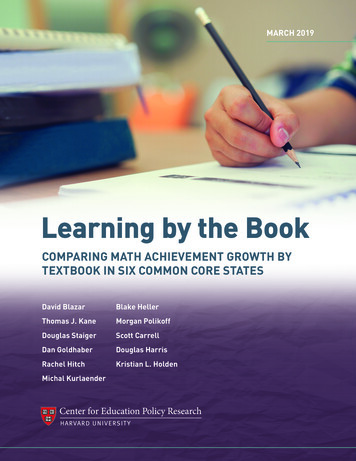
Transcription
MARCH 2019Learning by the BookCOMPARING MATH ACHIEVEMENT GROWTH BYTEXTBOOK IN SIX COMMON CORE STATESDavid BlazarBlake HellerThomas J. KaneMorgan PolikoffDouglas StaigerScott CarrellDan GoldhaberDouglas HarrisRachel HitchKristian L. HoldenMichal KurlaenderCenter for Education Policy Research (CEPR) cepr.harvard.edui
AUTHOR AFFILIATIONSDavid Blazar, University of MarylandBlake Heller, Harvard UniversityThomas J. Kane, Harvard UniversityMorgan Polikoff, University of Southern CaliforniaDouglas Staiger, Dartmouth CollegeScott Carrell, University of California, DavisDan Goldhaber, American Institutes for Research, University of WashingtonDouglas Harris, Tulane UniversityRachel Hitch, Harvard UniversityKristian L. Holden, American Institutes for ResearchMichal Kurlaender, University of California, Davis
SUGGESTED CITATIONBlazar, D., Heller, B., Kane, T., Polikoff, M., Staiger, D., Carrell, S.,.& Kurlaender, M. (2019).Learning by the Book: Comparing math achievement growth by textbook in six Common Core states.Research Report. Cambridge, MA: Center for Education Policy Research, Harvard University.We gratefully acknowledge funding from the Bill & Melinda Gates Foundation, the Charles andLynn Schusterman Foundation, the William and Flora Hewlett Foundation, and the BloombergPhilanthropies. The research reported here also was supported by the Institute of EducationSciences, U.S. Department of Education, through grant R305B150010 to Harvard Universityand Grant R305E150006 to the Regents of the University of California (Michal Kurlaender,Principal Investigator, UC Davis School of Education) in partnership with the CaliforniaDepartment of Education ( Jonathan Isler, Co-Principal Investigator). The opinions expressedare those of the authors and do not represent views of the Institute of Education Sciences,the philanthropic funders, the departments of education in any of the participating states, theresearch institutions, nor the advisory board members.Thomas Kelley-Kemple, Jake Kramer, and Virginia Lovison at Harvard University; LihanLiu at Tulane University; Matthew Naven and Derek Rury at the University of CaliforniaDavis provided excellent research assistance. Rachel Urso and Sophie Houstoun at Center forEducation Policy Research at Harvard University led the recruitment of schools and teachersfor our surveys, and Nate Brown at the University of Washington led additional outreach inWashington state. Eric Hirsch, Lauren Weisskirk and Mark LaVenia at EdReports providedinvaluable support and feedback in understanding the breadth of curriculum choices andtextbook alignment to the Common Core.Our project depended upon the collaboration and support of our state partners, including JohnWhite, Jessica Baghian, Kim Nesmith, Rebecca Kockler, and Alicja Witkowski at the LouisianaDepartment of Education; Carol Williamson and Debra Ward from Maryland Department ofEducation; Peter Shulman, James Riddlesperger, LaShona Burke, and Jessica Merville at theNew Jersey Department of Education; and Christopher Ruzkowski and Anthony Burns fromNew Mexico Public Education Department.The study also benefited from the experience and feedback from an advisory board of experts oncurriculum design and value-added methodology, including: Matthew Chingos (Urban Institute),Erin Grogan and Dan Weisberg (TNTP), Cory Koedel (University of Missouri), Darleen Opferand Julia Kaufman (RAND Corporation), Grover J. “Russ” Whitehurst (Brookings), DavidSteiner ( Johns Hopkins University), and Jason Zimba (Student Achievement Partners) who readdrafts of the report and provided comments.Finally, we thank the thousands of district leaders, school principals, administrators, andclassroom teachers who generously provided input about their curriculum choices to ensure thatour project was a success.
TABLE OF CONTENTSAbstract. 1Introduction. 2Literature Review. 4Prior Evidence on Textbook Effectiveness. 5Randomized Trials. 5Non-Experimental Studies. 6Motivation for Our Study. 6Data Collection. 7Textbook Adoptions. 7Teacher Survey. 11Student Achievement and Demographic Data. 12Empirical Methodology. 13Results. 15Teacher-Reported Use of Textbooks. 15Differences in Average Student Achievement Gains Between Textbooks . 19The Underlying Variation in Textbook Efficacy. 23Heterogeneity in Textbook Efficacy. 24Variation in Textbook Efficacy in Schoolsby Level of Teacher Usage. 24Variation in Textbook Efficacy by Years Since Adoption. 26Variation in Textbook Efficacy by Days of Textbook-AlignedProfessional Development. 26Textbook Efficacy among Pre- and Post-CCSS Texts. 26Additional Robustness Checks. 28Reconciling with the Previous Literature. 29Conclusion. 31References. 33Appendix. 36ivLearning by the Book RESEARCH REPORT
ABSTRACTCan a school or district improve student achievement simply by switching to a higher-qualitytextbook? The question is a timely one, as thousands of school districts have been adopting newtexts to align with the Common Core State Standards (CCSS). Indeed, we find that over 80%of schools in six Common Core states are using a CCSS-edition elementary math textbook, and93% of teachers reported using those textbooks in more than half their lessons. Few central officedecisions have a broader impact than textbook adoptions on the work that students and teachersdo every day.To explore the consequences of textbook choice for student achievement, we combined data onmath textbook use with fourth- and fifth-grade student test scores during the first three yearsof administration of CCSS-aligned assessments (2014–15 through 2016–17). Overall, we foundlittle evidence of differences in average achievement gains for schools using different mathtextbooks. We also did not find impacts of textbooks for schools where teachers reported aboveaverage levels of textbook usage, for schools that had been using the text for more than oneyear, or in schools that provided an above-average number of days of professional developmentaligned to the textbook. We also found some evidence of greater variation in achievement gainsamong schools using pre-CCSS editions, which may have been more varied in their contentprior to the use of common standards. Our results differ from previous research, including severalrandomized trials, which reported substantial differences in achievement gains for schools usingdifferent textbooks. We offer several possible explanations for the difference between our resultsand the previous literature.At current levels of classroom implementation, we do not see evidence of differences inachievement growth for schools using different elementary math textbooks and curricula. It ispossible that, with greater supports for classroom implementation, the advantages of certain textswould emerge, but that remains to be seen.Center for Education Policy Research (CEPR) cepr.harvard.edu1
INTRODUCTIONThe choice of textbook or curriculum is an enticing lever for district leaders seeking to improvestudent outcomes. Few central office decisions have such far-ranging implications for the workthat students and teachers do together in classrooms every day. Indeed, in our own survey, whichwe discuss below, we find that 93% of elementary math teachers in six U.S. states reported usingthe official district-adopted textbook or curriculum in more than half of their lessons.1 Givensuch widespread usage, helping school districts to switch from less to more effective materialsoffers a large potential “bang-for-the-buck” (Kirst, 1982; Whitehurst, 2009). As Chingos andWhitehurst (2012) point out, “ whereas improving teacher quality is challenging, expensive,and time consuming, making better choices among available instructional materials should berelatively easy, inexpensive, and quick” (p. 1).Textbook choice has been especially salient in recent years, after many states adopted the CommonCore State Standards (CCSS). In the years since CCSS adoption, large publishing houses (e.g.,Houghton Mifflin Harcourt, McGraw Hill, Pearson) have invested heavily in adapting existingtextbooks and curriculum materials to the new standards, and in writing new materials fromscratch. New York State spent over 35 million dollars to develop a set of curriculum materials,Engage NY, which are now widely used across the country (Cavanaugh, 2015). As of 2016-17, over80% of the schools in our sample had adopted a CCSS-edition in elementary math.Despite the potential value to districts and schools, the research literature on the efficacy ofalternative textbooks or curricula is sparse. We are aware of one multi-textbook randomizedtrial (Agodini et al., 2010), two randomized trials assessing the effectiveness of a single textbook(Eddy et al., 2014; Jaciw et al., 2016), and a handful of non-experimental studies (Bhatt &Koedel, 2012; Bhatt, Koedel, & Lehmann, 2013; Koedel, Polikoff, Hardaway, & Wrabel, 2017).However, most of the textbook editions or curriculum materials in common use today have neverbeen subjected to a rigorous test of efficacy (Chingos & Whitehurst, 2012).One reason for the weakness of the evidence base is the historic diversity in state standards andassessments. When each state had its own standards and assessments, single-state studies wererelevant only for schools in a given state, and few states were sufficiently large to justify the costof such an analysis. A second, more practical barrier has been the omission of textbook adoptionsfrom state data collection efforts (Polikoff, 2018). As useful as adoption data would be formeasuring efficacy, states have concentrated their data collection efforts on fulfilling accountabilityrequirements, rather than informing district decision-makers. Historically, many states have stayedaway from collecting data on curriculum adoptions in deference to local authorities (Hutt &Polikoff, 2018). We are aware of only six states that regularly collect information on the textbooksused by schools: California, Florida, Indiana, Louisiana, New Mexico, and Texas.2 As a result, it1 Throughout the paper, we use the terms “textbook” and “curriculum” interchangeably. We recognize, though, thatthe physical textbook may be just one of multiple materials that make up a given curriculum. Curricula can includestudent and teacher editions of the textbook, formative assessment materials, manipulative sets, etc. In our survey toschools and teachers, we referred to the “primary textbook or curriculum materials” used by teachers, which couldconsist of “a printed textbook from a publisher, an online text, or a collection of materials assembled by the school,district, or individual teachers [but] does not include supplemental resources that individual teachers may use fromtime to time to supplement the curriculum materials.”2 California schools are mandated under law to report curriculum materials on school accountability report cards2Learning by the Book RESEARCH REPORT
has been difficult to bring to bear states’ longitudinal data on student achievement to compare theachievement gains of similar schools using different curricula.Ours is the first multi-state effort to measure textbook efficacy in the CCSS era. We began byassembling data on math textbook adoptions in fourth- and fifth-grade classrooms in six states(California, Louisiana, Maryland, New Jersey, New Mexico, and Washington state) over threeacademic years (2014–15 through 2016–17). Our study period coincides with the first years oftesting by the two CCSS assessment consortia, the Smarter Balanced Assessment Consortium(SBAC) and the Partnership for Assessment of Readiness for College and Career (PARCC). Intwo states, California and New Mexico, we assembled data on textbook use in elementary mathfrom administrative records. In the remaining states, we surveyed a stratified random sample of1,086 elementary schools to learn which math textbooks they were using.In a second phase, we collected information from a subsample of teachers using one of the topseven most frequently used curricula. The roughly 20-minute online survey asked about teachers’use of textbook materials for various purposes (lesson planning, student assessment, etc.). Wealso asked about teachers’ use of supplementary materials (including educational software), thepresence of math coaches in the school, and professional development related to math instructionor math curriculum. We selected a random sample of roughly 60 schools per curriculum andrecruited the fourth- and fifth-grade teachers in each of the selected schools.In the third phase, we assembled student-level achievement data over time to estimate schoollevel differences in average student achievement growth, adjusting for differences in students’baseline achievement and demographics—that is, school-level “value-added” (for a discussion ofthe validity of school-level value-added measures, see Angrist et al., 2017; Deming, 2014).3We summarize our findings below:»» Despite a plethora of options, including open source curriculum materials, the elementarymath textbook market remains fairly concentrated. Roughly 70% of elementary schoolsin the six states used one of seven texts, and 90% used one of 15 texts (out of a total of 38textbooks identified in our sample).»» Despite the fact that the six states had similar standards and assessments, the market sharefor particular curricula varied by state. For instance, in New Mexico, the market was nearlyevenly split among three textbook series, enVision, My Math, and Stepping Stones, all ofwhich were written for or adapted to the CCSS. Comparatively, in Louisiana, almost 60%of schools used Engage NY, an open source curriculum written for the CCSS (also publishedunder the title Eureka).(Holden, 2016; Hutt & Polikoff, 2018). In Florida and Indiana, centralized adoption processes allow state agencies tocapture information on districts’ adoption of certain texts (Bhatt & Koedel, 2012; Bhatt, Koedel, & Lehmann, 2013).New Mexico collects curriculum data based on purchasing records from a state-organized curriculum warehouse,and these records can be attached to individual schools. Recently, Louisiana has started to collect data on textbookadoptions through district and school surveys. Texas tracks adoption data based on requisitions and disbursements,and posts this information on a public website.3 For our study, we assume that the school value-added measures are “forecast-unbiased”.Center for Education Policy Research (CEPR) cepr.harvard.edu3
»» The vast majority of teachers (93%) reported using the official curriculum in more than halfof their lessons for purposes such as creating tasks/activities for class, selecting examples topresent, or assigning problems for independent practice or homework; 76% reported thatthey used the curriculum for one of these purposes during “nearly all” of their lessons. At thesame time, only 25% of teachers reported using the textbook in nearly all their lessons for allessential activities, including in-class exercises, practice problems, and homework problems.»» Nevertheless, unlike the prior literature (Agodini et al., 2010; Bhatt & Koedel, 2012;Bhatt et al., 2013; Koedel et al., 2017), we found little evidence of substantial differencesin average math achievement growth in schools using different elementary math curricula.Although we saw substantial variation in achievement growth among the schools using eachcurriculum, the differences in average achievement growth between curricula are small. Ourfindings are similar for specific subgroups of students, by English language learner (ELL)status, free or reduced-price lunch status (a proxy measure of socioeconomic status), andhigh- or low-baseline achievement. The variance in textbook efficacy also was not significantin the subset of schools in which teachers reported the highest average levels of textbookusage, or in schools that had been using the text for two or more years.Below, we briefly review the literature on the implementation and efficacy of curriculummaterials. In subsequent sections, we describe our data and methodology, and present resultson teachers’ use of textbook and measured efficacy. Afterwards, we attempt to reconcile ourfindings with the prior literature on textbook effects, especially the randomized controlled trialconducted by Agodini et al. (2010). We discuss the role of possible biases in our value-addedmethodology, possible limits on the generalizability of the randomized controlled trial, the role ofimplementation, and the possible greater uniformity in textbook coverage following the CCSS.We conclude with a discussion of the implications of our results for policy and future research.LITERATURE REVIEWEach year, schools and districts spend upwards of 10 billion on textbooks and other instructionalmaterials (Boser, Chingos, & Straus, 2015; McFarland et al., 2017). However, districts must selectcurricula in the absence of evidence of efficacy, relying instead on the judgements of central officestaff, textbook selection committees, and the choices of neighboring districts (for a review of theadoption literature and new qualitative analyses, see Polikoff et al., 2018). Of the 38 textbooks weobserve in our sample, only five have been evaluated in a manner meeting the highest evidencestandards of the federal What Works Clearinghouse (WWC), a repository for education research.Only three of these are among the top 15 most commonly used textbooks in our sample.One recent study describing teachers’ instructional decisions in the CCSS era suggests thattextbooks are a primary resource for math instruction, although not the sole source. In anationally representative survey of schools, Opfer et al. (2016) found that 98% of elementarymath teachers reported using instructional materials selected or developed by district leadership.Roughly 85% of teachers reported that their districts required (57%) or recommended (27%) thatthey use specific textbooks to teach mathematics. At the same time, the authors observed thatteachers often used other materials, including lessons from online resources (e.g., Google.com,Pinterest.com) to supplement their primary textbook.4Learning by the Book RESEARCH REPORT
PRIOR EVIDENCE ON TEXTBOOK EFFECTIVENESSWe discuss the past research on math textbook efficacy in two broad categories: randomized trialsand non-experimental studies.Randomized TrialsTo our knowledge, only one study has used a randomized design to compare the impact ofmultiple elementary math textbooks on student achievement.4 Agodini et al. (2010) randomlyassigned one of four curricula to 111 schools in 12 districts across 10 states. All four curriculawere published prior to the roll out of the CCSS: Investigations in Mathematics, Math Expressions,Saxon Math, or Scott Foresman-Addison Wesley Elementary Math (SFAW). The study took placeduring three school years (2006–07, 2007–08, and 2009–10) and focused on first- and secondgrade classrooms. Teachers received 1–2 days of training on the assigned textbook in the summerbefore implementation and an additional 1.5 days during the following spring. (The amountof training was similar to that reported by teachers in our surveys.) Second-grade classroomsusing Math Expressions or Saxon Math outperformed those using SFAW by 0.12 SD and 0.17SD respectively.5 These effect sizes are quite large relative to the vast majority of educationalinterventions (Fryer, 2017). For instance, they would be larger than the effect of having anexperienced teacher versus a novice teacher (generally found to be roughly 0.08 SD) and roughlyequivalent to a 1 SD increase in teacher efficacy.Two other studies used randomized designs to study individual curricula. Eddy et al. (2014)randomly assigned the Go Math curriculum to first- through third-grade classrooms in nineschools across seven states during the 2012–2013 school year. After one year, the authors didnot find statistically significant differences in student achievement. Jaciw et al. (2016) evaluatedthe effectiveness of the Math in Focus textbook (modelled after a Singaporean math curriculum)by randomly assigning 22 clusters of third- through fifth-grade teachers in 12 schools in ClarkCounty School District (Las Vegas) in Nevada during the 2011–2012 school year. Teachersattended a short training session (1.5 to 3 hours) during the summer before, and four half-day4 Several additional studies that attempted to use randomized designs to evaluate specific curricula were rejectedfrom the What Works Clearinghouse (WWC)—a repository of education research—for failing to meet inclusionstandards, generally due to imbalance between groups at baseline. Two doctoral dissertations cited by WWC usedexperimental designs to evaluate textbook effectiveness but never were published and rely on extremely smallsamples (N 100 students). WWC reviews two additional studies with randomized designs that meet their evidencestandards; however, these studies are not available online (Beck Evaluation & Testing Associates Inc., 2005; Gatti& Giordano, 2010). In a currently unpublished review, Pellegrini et al. (2018)—updated from an earlier publishedreview of the same topic (Slavin & Lake, 2008)—also cite a recent randomized evaluation of enVision Math 2.0 thatis not available online (Strobel, Resendez, & DuBose, 2017). At the time of writing, we were unable to obtain accessto review these studies. Additionally, Pellegrini et al. (2018) cite results from randomized trials evaluating EverydayMathematics and JUMP Math textbooks that were gleaned from conference presentations, where a full description ofeach study’s experimental design and associated balance tests are not available online.There also are several randomized evaluations of math materials, which we see as different from the textbooksevaluated by Agodini et al. (2010) and that we examine in our studies. Math software products that sometimes aredescribed as curriculum, including Cognitive Tutor Bridge to Algebra, Compass Learning’s Odyssey Math, PLATOAchieve Now, and Larson Pre-Algebra, have been subjected to randomized evaluations. In our study, we define thesematerials as supplemental and not the primary curriculum to teach mathematics. Jackson and Makarin (2018)experimentally evaluated the effectiveness of “off-the-shelf” curriculum materials for middle school math teachers,which we distinguish from complete textbooks.5 Agodini et al. (2010), Table III.2.Center for Education Policy Research (CEPR) cepr.harvard.edu5
or full-day sessions throughout the year.6 The authors found that students in grade-level teamsrandomly assigned to adopt Math in Focus outperformed students in the control group by 0.11to 0.15 SD on the Stanford Achievement Test (10th edition) at the end of the first year of usage.However, the study team found no impact of Math in Focus on the criterion-referenced testrequired by the state of Nevada.Non-Experimental StudiesIn addition to the randomized trial, a handful of non-experimental studies have identified effects oftextbooks on student achievement gains. For example, Koedel and co-authors used matching methodsand school-level aggregate achievement to measure textbook efficacy in three states: California,Florida, and Indiana (Bhatt & Koedel, 2012; Bhatt, Koedel & Lehmann, 2013; Koedel et al., 2017).Given the large number of texts used in California and Florida, the analysts used a two-step processin those states. They first identified a differently effective or widely used text based on an initialexploratory analysis. They then subsequently compared that text against a composite comparisongroup. Although it helps to narrow the focus of inquiry, the danger is that the initial exploration mayidentify the “winning” text due to chance differences in achievement. (For the analysis in Indiana, theydid not have to winnow down the texts beforehand.) Although the authors are careful to conduct anumber of validity tests in the second step—e.g., verifying that the timing of any achievement increasealigned with the textbook adoption and that achievement did not grow in English Language Arts(ELA)—such tests would not necessarily reveal a within-sample anomaly.7The only textbook that appears in both the randomized trial and the non-experimental studiesconducted by Koedel and collaborators (i.e., Bhatt & Koedel, 2012) is Saxon Math. The textwas among the most effective in the randomized trial, but was among the lower-performingtextbooks in the non-experimental analysis.8MOTIVATION FOR OUR STUDYWe designed our study as a field test of a replicable, low-cost approach to measuring curriculumefficacy. By estimating value-added models in states using CCSS-aligned assessments, weeliminated the need to collect our own assessments or to recruit schools to switch textbooks. Inaddition, by coordinating with researchers in other states—each team estimating the same modelwith student-level data and then sharing only aggregated data with us—we reduced the need toshare student-level data across state lines. Finally, by collecting textbook data for a random sampleof schools, we ensured that we had a representative sample of schools (at least in these six states)and were focused on the textbook editions that schools were using in the present CCSS-era. By6 The amount of training was more than the average we found in our sample, but roughly equivalent to the top half ofschools in our sample in terms of days of teacher training on the text.7 WWC and Pellegrini et al. (2018) cite several non-experimental evaluations of single textbooks. We omit theseevaluations from our literature review and focus on non-experimental analyses that compare multiple textbooks,preferencing the highest-quality research designs (randomized trials) or multi-textbook evaluations that are mostsimilar to our own study.8 The difference in efficacy for Saxon Math in the RCT and in the Koedel et al. studies might not be due to themethodological differences alone. As Koedel et al. discuss, Saxon Math, as a highly scripted curriculum, wasdesigned for implementation in schools where the teachers have weak math backgrounds, the very type of schoolsthat participated in the RCT.6Learning by the Book RESEARCH REPORT
relying on secondary assessment data and the textbook editions in use today, we designed the studyso that the same methodology could be used to update results as textbook editions come and go.Although randomized trials may be the most convincing way to estimate the causal effect oftextbooks for a given sample of schools, the estimated impacts might not generalize beyond thesmall subset of schools that are willing to have their textbooks randomly assigned. By relying onschool-level value-added, we have to make stronger statistical assumptions—namely, that we areable to control for the key differences between schools using different texts. However, the benefit isthat we are able to estimate value-added for nearly every school in the six states we are studying.DATA COLLECTIONOurs is the only study in the CCSS era to examine the efficacy of multiple textbooks,incorporating data from over 6,000 schools and a random sample of roughly 1,200 teachersacross six states. We used the Common Core of Data (CCD) to construct a sampling frame ofpublic schools enrolling fourth- and fifth-grade students. We included public charter schoolsbut excluded private schools. We measured school achievement gains during three school years:2014–15 through 2016–17. To do the analysis, we relied on three types of data—(1) textbookadoptions, (2) teachers’ self-reported use of curriculum materials, and (3) student achievementand demographics—which we describe in turn below. See Table 1 for a summary of the sample ofschools and years by state.Table 1. Sample of Schools and TeachersAvailableSchool Years# of Schoolswith ReportedTextbook Data# of SampledSchools# Schools inSampling Frame# of SampledSchools (Teachers) for TeacherSurveyAdministrative Data StatesCalifornia2014–15
Douglas Staiger Dan Goldhaber Rachel Hitch Michal Kurlaender Blake Heller Morgan Polikoff Scott Carrell Douglas Harris Kristian L. Holden Learning by the Book COMPARING MATH ACHIEVEMENT GROWTH BY TEXTBOOK IN SIX COMMON CORE STATES. AUTHOR AFFILIATIONS . Washington state. Er ic Hirsch


